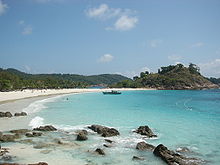
Malaysia is the 67th largest country by total land area, with a land area of 329,847 km2 (127,355 sq mi). It has land borders with Thailand in West Malaysia, and Indonesia and Brunei in East Malaysia.[2] It is linked to Singapore by a narrow causeway and a bridge. The country also has maritime boundaries with Vietnam[90] and the Philippines.[91] The land borders are defined in large part by geological features such as the Perlis River, the Golok River and the Pagalayan Canal, whilst some of the maritime boundaries are the subject of ongoing contention.[2] Brunei forms what is almost an enclave in Malaysia,[92] with the state of Sarawak dividing it into two parts. Malaysia is the only country with territory on both the Asian mainland and the Malay archipelago.[93] Tanjung Piai, located in the southern state of Johor, is the southernmost tip of continental Asia.[94] The Strait of Malacca, lying betweenSumatra and Peninsular Malaysia, is one of the most important thoroughfares in global commerce, carrying 40 per cent of the world's trade.[95]

The two parts of Malaysia, separated from each other by the South China Sea, share a largely similar landscape in that both Peninsular and East Malaysia feature coastal plains rising to hills and mountains.[2]Peninsular Malaysia, containing 40 per cent of Malaysia's land area,[93] extends 740 km (460 mi) from north to south, and its maximum width is 322 km (200 mi).[97] It is divided between its east and west coasts by the Titiwangsa Mountains,[98] part of a series of mountain ranges running down the centre of the peninsula.[93] These mountains are heavily forested,[99] and mainly composed of granite and other igneous rocks. Much of it has been eroded, creating a karst landscape.[93] The range is the origin of some of Peninsular Malaysia's river systems.[99] The coastal plains surrounding the peninsula reach a maximum width of 50 kilometres (31 mi), and the peninsula's coastline is nearly 1,931 km (1,200 mi) long, although harbours are only available on the western side.[97]
East Malaysia, on the island of Borneo, has a coastline of 2,607 km (1,620 mi).[2] It is divided between coastal regions, hills and valleys, and a mountainous interior.[93] The Crocker Range extends northwards from Sarawak,[93] dividing the state of Sabah. It is the location of the 4,095.2 m (13,436 ft) high Mount Kinabalu,[100] the tallest mountain in Malaysia. Mount Kinabalu is protected as the Kinabalu National Park, a UNESCO World Heritage Site.[101] The highest mountain ranges form the border between Malaysia and Indonesia. Sarawak contains the Mulu Caves, the largest cave system in the world.[93]